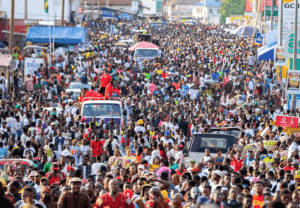Like most traditional festivals in Ghana, the ‘Te Za’ of the Asɔgli State delivers joy that unites its people. Kofi Dro, who was at the recent event, and PaJohn Bentsifi Dadson file this report.
It’s just gone past 3 o’clock in the afternoon. The vibration in the air has changed gears. You can tell matters are about to get even more intoxicating.
All day, the town has been charged with sporadic blasts of melodies by various traditional groups gathered under trees and at street corners drumming, singing, dancing in much merriment.

Now, with the Dzawuwu – a ritual of serving the gods and ancestors with the first yam meal called “bakabake” before any living being tastes it in all stool houses, shrines and certain individual homes – completed, the big procession begins!
Meandering through the principal streets of Ho from the suburb of Bankoe where it begins, it will make its way, over the next three or so hours to the park at Mawuko Girls’ Senior High School. It is a long walk. However, led by the elder warriors from the family and royal houses of Asɔgli who, clad in traditional regalia, play the ‘Gankogui’ in rhythm to their march.
Floating conspicuously in the centre-forward position of the parade, flung on either side by men in traditional regalia, a female in similar warrior garment struts, carrying on her head a single tuber of yam wrapped in strings of ‘nyanya’ leaves that fall over her shoulders. Behind them in the hierarchy, walking rather majestically, are some chiefs and queen mothers in traditional garb. Then the rest of the people.
Onlookers line the route, many following the parade on the pavements in an attempt to witness the ceremonies and rituals that take place along the way. In the back, the citizens and visitors float along, dancing and joining in the merry-making.
There’s a brief stop at the ‘K.K. House’ roundabout where the elders lead in performing libations to herald the commencement of Teyuyru, or the “hailing of the new yam”, signalling the official lifting of the ban on entry of the new yam into Asɔgli towns.
Early on at the forest at Akoefe where the Dzawuwu takes place, a concoction of ‘Nubabla’ – holy herbs – given to elders of key family and royal houses to be placed at vantage homes in town to ward off evil spirits were in place. Repeatedly throughout the procession, elder warriors walk up to the tables set in front of the homes along the route, fetch a mini calabash full of the Nubabla and sprinkle its contents in the vicinity.
Here at the school park where the procession has now halted, the ‘soloku’ or merry-making that has ensued is of epic dimensions. Low loaders packed with speakers blast loud music everywhere, and everyone is just jigging away with abandon! Heads are spinning, bodies gyrating as though everyone is possessed!
The best place to be, though, is right here under the big tree, where a troupe of drummers, along with dancers, are delivering a frenzied rendition of a boborbor feast as has never been heard or seen before! It’s a delicious spectacle, in rhythm and movement, and it seems to have triggered all nearby to join in dancing!
You don’t really realise how huge the crowd size is, being in the midst of it all. Not until you step away do you see the density of folk strutting along. The sheer magnitude of it is mesmerising.
Hazarding a guess, there could easily be a couple of thousand people on the streets of Ho for this procession. This year’s much-anticipated ‘Te Za’ – the ‘Yam Festival’ – of the people of Ho has really just begun! It will climax in a week with a grand durbar, where the Agbogbomefia of the Asɔgli State in the Volta Region, His Majesty Togbe Afede XIV, along with all the divisional chiefs and heads of family of Asɔgli clans will sit in state to receive citizens and visitors from all over.
Previously known as the Asɔgli Yam Festival, the customary ritual is celebrated annually in September as a homecoming to herald the yam harvest season by the Ewe ethnic group of the Asɔgli Traditional Area in the Ho Municipality of the Volta Region. This year, it was held under the theme ‘Let’s Ensure Freedom and Justice for All’.
Instituted centuries ago prior to their exodus from Notsé – the prosperous city-state located in what is present-day Togo, the festival was started by a hunter. Legend has it that having hidden a tuber he found during a hunting expedition, he returned to find the yam had germinated, growing into several tubers. An important occasion that binds the people, the festival followed them even after their migration from Notsé in reaction to the tyranny of their king, Agokoli (1670-1720).
The king’s reign, epitomised by his desire to erect a monumental sacred enclosure in Notsé, caused a number of the city’s inhabitants to exile themselves, some moving westward, and settling in areas including here in the eastern part of Ghana. Many of them can be found in the Ho area – the capital of Volta Region, which is also the capital of Asɔgli State.
Before the advent of colonialism, they were an autonomous kingdom founded by the direct descendants of Togbe Kakla who had led them out of Notsé. Comprising four traditional set-ups – Akoefe, Ho, Kpenoe and Takla, the paramountcy covers an area from Atimpoku in the west after the Volta river, through Ho to Aflao in the east, with several paramount chiefs, all swearing allegiance to the Agbogbomefia – King of the Asɔgli State.
Celebration of the festival, curtailed for over a decade in recent times, was reinstated in 2004 by Togbe Afede, with the aim to educate and entertain both Ghanaians and visitors about Asɔgli traditions. This is what has led to the festival’s current incarnation that provides great opportunity to experience traditional music, dance and storytelling highlighting insights into the people of Asɔgli.
Places to stay at Ho
- Villandro
- Volta Serene










